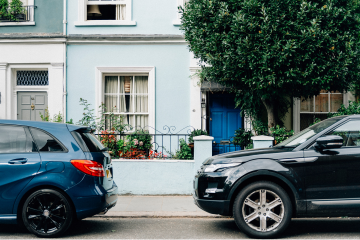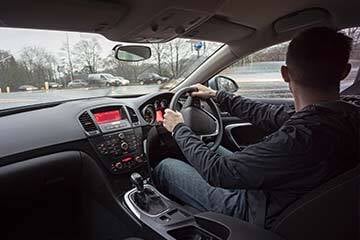There are several reasons why your vehicle could end up being seized by the police, whether that’s driving without tax or leaving it abandoned.
To retrieve an impounded car, you need to have it insured for at least 30 days. If you don’t have valid insurance, temporary car insurance offers you the short-term cover you need to get it back. But why are vehicles most likely to be impounded and which police forces seize the most?
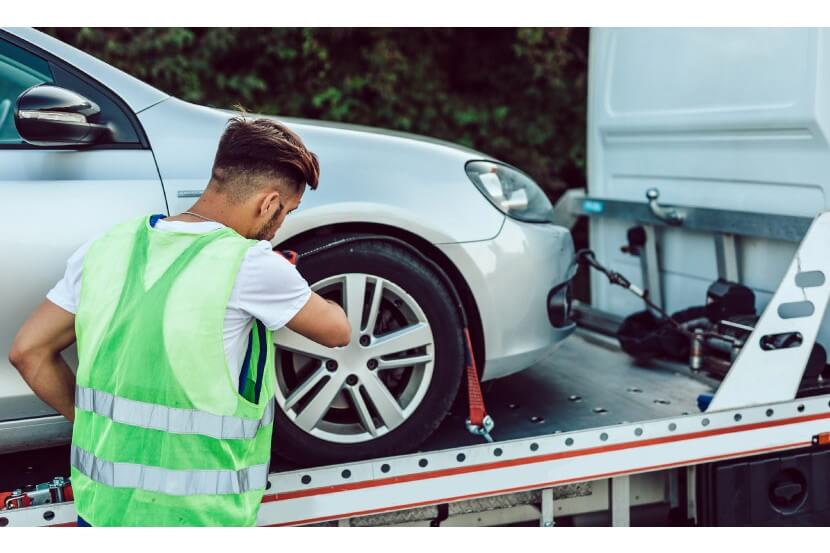
Why are vehicles seized?
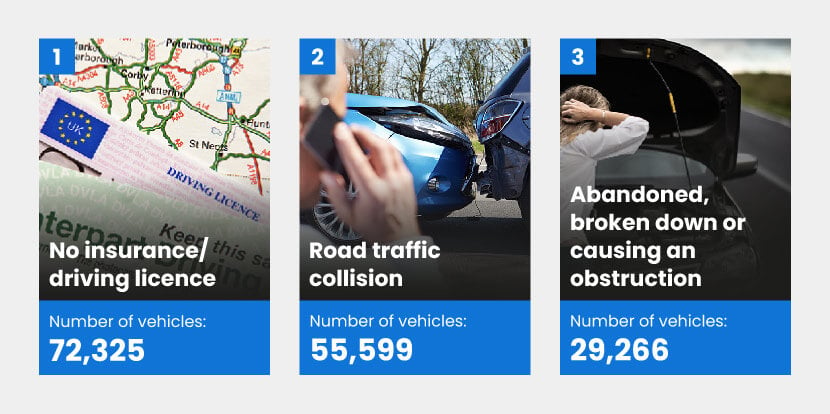
1. No insurance/driving licence - 72,325 vehicles
The most common reason people have their vehicles taken by the police is driving without insurance or a licence. In 2021, over 70,000 vehicles were seized for this reason.
Driving without insurance is illegal and even if the vehicle itself is insured by someone else, you must also be insured to drive it. You risk having the vehicle taken away, and you could also get a fixed penalty of £300 and 6 penalty points.
2. Road traffic collision - 55,599 vehicles
The second most common reason for vehicles being taken away is due to them being involved in a road traffic collision (RTC).
Over 55,000 vehicles were seized for this reason. The police may need the vehicle for evidence, or in some cases, they remove a vehicle when a recovery service isn’t able to.
3. Abandoned, broken down or causing an obstruction - 29,266 vehicles
The police can also move vehicles that they believe to have been abandoned or are causing an obstruction. There are several reasons that could be behind this, but they tend to fall under section 99 of the Road Traffic Act[1]. If your vehicle is causing an obstruction, officers should give you a reasonable chance to move it prior to them seizing it.
| Rank | Reason | Number of vehicles |
|---|---|---|
|
1
|
No insurance/driving licence
|
72,325
|
|
2
|
Road traffic collision
|
55,599
|
|
3
|
Abandoned broken down or obstructively parked
|
29,266
|
|
4
|
Stolen
|
22,078
|
|
5
|
Used in crime/traffic offence
|
16,907
|
|
6
|
Removed at owner's request following breakdown/RTC
|
9,280
|
|
7
|
No tax
|
7,474
|
|
8
|
Other/unknown
|
3,461
|
|
9
|
Removal of police vehicles from the road
|
2,185
|
|
10
|
Driving in an antisocial manner
|
1,727
|
|
11
|
Burnout
|
1,466
|
Most common impound areas
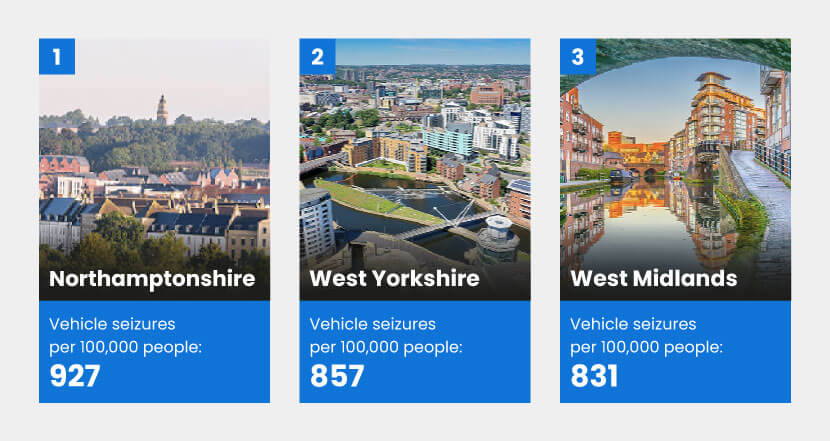
1. Northamptonshire - 927 per 100,000 people
When compared to the size of the population, Northamptonshire sees the most vehicle seizures.
There were a total of 7,021 vehicles seized by the local police in 2021, which equates to 927 per 100,000 people in the area. The most common reason for these seizures was that the vehicles had been involved in a road traffic collision.
The county was also among the areas where the fewest people actually got their vehicles back, at a recovery rate of 65.1%,
2. West Yorkshire - 857 per 100,000 people
One of the biggest police force areas, West Yorkshire, comes in second with 857 vehicles seized per 100,000 people.
Over 20,000 vehicles were impounded in the county in 2021. Here, the most common reason for vehicles being seized was driving without insurance, with just under 7,000 seizures.
Roughly two-thirds (66.39%) of vehicles that were impounded in 2021 were returned to their owners.
3. West Midlands - 831 per 100,000 people
The area covered by West Midlands Police, another of the country’s biggest, comes in third place, with 831 vehicles seized per 100,000 people.
Over 9,000 of these vehicle seizures were due to drivers not having the correct insurance or a valid driving licence.
West Midlands is also the area where the fewest vehicles were returned, with just 57.53% recovered.
| Rank | Police force area | Population | Total vehicles seized | Vehicles seized per 100,000 people |
|---|---|---|---|---|
|
1
|
Northamptonshire
|
757,200
|
7,021
|
927
|
|
2
|
West Yorkshire
|
2,345,200
|
20,107
|
857
|
|
3
|
West Midlands
|
2,939,900
|
24,420
|
831
|
|
4
|
Warwickshire
|
583,800
|
4,831
|
828
|
|
5
|
Cleveland
|
569,800
|
4,665
|
819
|
|
6
|
Gwent
|
598,200
|
4,684
|
783
|
|
7
|
South Yorkshire
|
1,415,100
|
10,908
|
771
|
|
8
|
Durham
|
640,600
|
4,284
|
669
|
|
9
|
Bedfordshire
|
682,300
|
4,534
|
665
|
|
10
|
Lancashire
|
1,515,500
|
9,908
|
654
|
|
11
|
Staffordshire
|
1,139,800
|
7,266
|
637
|
|
12
|
Hertfordshire
|
1,195,700
|
7,227
|
604
|
|
13
|
Gloucestershire
|
640,700
|
3,752
|
586
|
|
14
|
Cambridgeshire
|
859,800
|
4,805
|
559
|
|
15
|
Dyfed-Powys
|
522,700
|
2,887
|
552
|
|
16
|
Northumbria
|
1,470,400
|
7,958
|
541
|
|
17
|
Cumbria
|
499,800
|
2,696
|
539
|
|
18
|
Kent
|
1,868,200
|
9,748
|
522
|
|
19
|
Derbyshire
|
1,064,000
|
5,523
|
519
|
|
20
|
North Wales
|
703,400
|
3,611
|
513
|
|
21
|
North Yorkshire
|
831,600
|
4,256
|
512
|
|
22
|
West Mercia
|
1,298,400
|
6,621
|
510
|
|
23
|
Norfolk
|
914,000
|
4,533
|
496
|
|
24
|
Essex
|
1,856,100
|
9,184
|
495
|
|
25
|
Merseyside
|
1,434,300
|
6,337
|
442
|
|
26
|
Suffolk
|
761,200
|
3,288
|
432
|
|
27
|
Wiltshire
|
727,000
|
2,950
|
406
|
|
28
|
Devon and Cornwall
|
1,785,300
|
7,125
|
399
|
|
29
|
Northern Ireland
|
1,895,510
|
7,174
|
378
|
|
30
|
Hampshire
|
1,999,100
|
7,412
|
371
|
How many seized vehicles are returned?
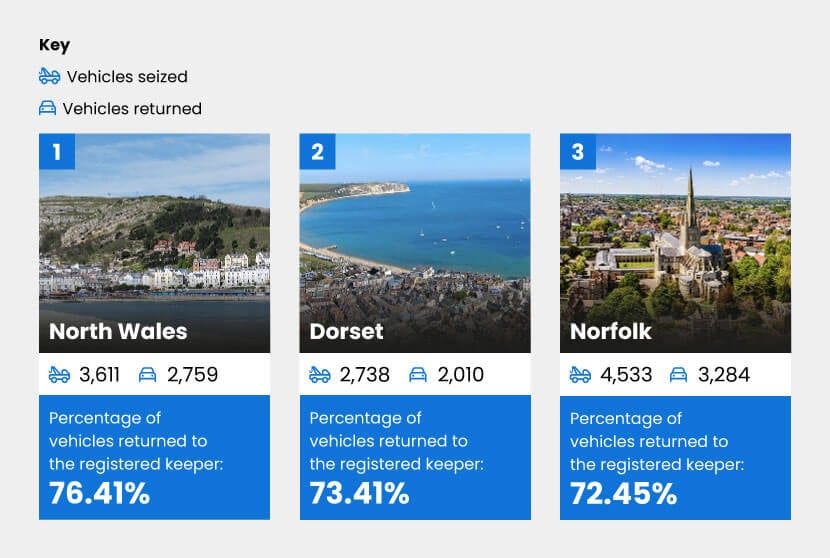
If the police seize a vehicle, you can recover it in certain circumstances. Of the 44 police forces contacted, 21 provided both the number of seizures and the number of vehicles recovered by owners.
Among these 21 areas, 172,694 vehicles were seized, with 114,076 being returned to the registered keeper. That means that roughly a third of seized vehicles are returned to their owners.
The area with the highest recovery rate is North Wales, where 76.41% of seized vehicles were returned. That compares to just 57.53% in the West Midlands, which had the fewest vehicles returned.
| Rank | Police force area | Vehicles seized | Vehicles returned | Vehicles returned (%) |
|---|---|---|---|---|
|
1
|
North Wales
|
3,611
|
2,759
|
76.41%
|
|
2
|
Dorset
|
2,738
|
2,010
|
73.41%
|
|
3
|
Norfolk
|
4,533
|
3,284
|
72.45%
|
|
4
|
Hertfordshire
|
7,227
|
5,137
|
71.08%
|
|
5
|
Scotland
|
19,946
|
14,175
|
71.07%
|
|
6
|
North Yorkshire
|
4,256
|
3,023
|
71.03%
|
|
7
|
Warwickshire
|
4,831
|
3,375
|
69.86%
|
|
8
|
Suffolk
|
3,288
|
2,271
|
69.07%
|
|
9
|
Lancashire
|
9,908
|
6,843
|
69.07%
|
|
10
|
Derbyshire
|
5,523
|
3,766
|
68.19%
|
How to reclaim an impounded vehicle
If you have your vehicle impounded, it’s possible to reclaim it. But the process isn’t necessarily straightforward.
Assuming that the police are happy to release your vehicle, there are a few steps you have to follow.
First, you need to find out exactly where the car is being held. If this isn’t stated on the notice letter that you get from the police, you can call your local police station on 101 to find out.
Following this, there are various documents that you have to provide. These include:
- The seizure notice
- Proof of identity
- Proof of ownership
- Valid MOT
- Insurance certificate
There’s usually a fee to pay to reclaim your vehicle, which depends on the size and weight of the vehicle.
While someone else can pick up your vehicle, they can only do so once the registered keeper has provided the correct documentation and paid any charges.
If your vehicle was impounded because you didn’t have insurance, then you may need to get impound insurance. This is a short-term policy that proves that you have at least 30 days of insurance for the vehicle (a legal requirement).
Louise Thomas, car insurance expert at Confused.com, comments:
“There are many reasons why the police might seize your car, and often these reasons can be avoided by staying on top of your admin and policies.
“We associate cars being impounded with dramatic incidents such as road traffic collisions, breakdowns and theft. While these are all valid reasons for a seizure, the most common offences in 2021 were driving with no insurance or driving licence. Retrieving an uninsured vehicle will be time-consuming and expensive and you need to get temporary car insurance for the journey home. Driving without a licence could also result in a fine of £1,000.
“The best way to ensure that you aren’t driving illegally is to check that your existing car insurance policy covers you. It’s always worth doing a quick licence check too to see if your driving licence needs renewing.”




